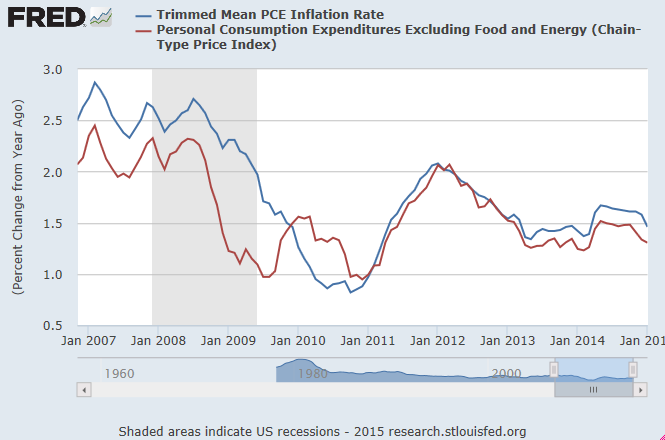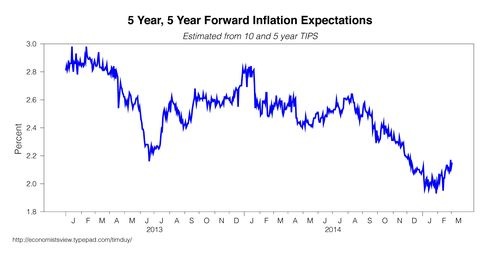In the wake of the very strong NFP report last week, Tim Duy wrote a post indicating that "Patient" is History. He laid out his reasoning in a previous post:
My take is this: To get a reasonably sized consensus to support a rate hike, two conditions need to be met. One is sufficient progress toward full-employment with the expectation of further progress. I think that condition has already been met. The second condition is confidence that inflation will indeed trend toward target. That condition has not been met. To meet that condition requires at least one of the following sub-conditions: Rising core-inflation, rising market-based measures of inflation compensation, or accelerating wage growth. If any were to occur before June, I suspect it would be the accelerating wage growth.
Duy went on to say that he was not confident that we would see accelerating wage growth, or any upside from core inflation. I agree with that assessment and I posted these charts of wage growth and core inflation on the weekend (see Bullish, but "data dependent"). Here is the chart of the growth in Average Hourly Earnings.

Here is Core PCE and its sister metric, Trimmed Mean PCE:

Tim Duy went on to hang his hat of inflationary pressures on rising inflationary expectations from the bond market.
So wage growth might not be there in June to support a rate hike. And, as I noted earlier this weaker, I have my doubts on whether core-inflation would support a rate hike either. That leaves us with market-based measures of inflation compensation. And at this point, that just might be the key:

If bond markets continue to reverse the oil-driven inflation compensation decline, the Fed may see a way clear to hiking rates in June. But the pace and timing of subsequent rate hikes would still be data dependent. I would anticipate a fairly slow, halting path of rate hikes in the absence of faster wage growth.
Market or survey based inflationary expectations?
But the Fed has made it clear it doesn't really trust market based inflationary expectations and prefers to measure inflationary expectations from surveys. Here is what Janet Yellen said in response to a Greg Ip question about the 5Y5Y metric at the December 17, 2014 press conference (emphasis added):
Well, what I would say, we refer to this in the statement as “inflation compensation” rather than “inflation expectations.” The gap between the nominal yields on 10-yearTreasuries, for example, and TIPS have declined—that’s inflation compensation. And five-year, five-year-forwards, as you’ve said, have also declined. That could reflect a change in inflation expectations, but it could also reflect changes in assessment of inflation risks.
The risk premium that’s necessary to compensate for inflation, that might especially have fallen if the probabilities attached to very high inflation have come down. And it can also reflect liquidity effects in markets. And, for example, it’s sometimes the case that— when there is a flight to safety, that flight tends to be concentrated in nominal Treasuries and could also serve to compress that spread. So I think the jury is out about exactly how to interpret that downward move in inflation compensation.
While the explanation is somewhat unclear and unsatisfactory, Yellen makes it clear that she believes that there are other terms that are in the 5Y5Y figure. In other words, it is not a "pure" measure of inflationary expectations.
Latest survey: Falling inflation
In that case, what does the latest survey data say? The WSJ reported on the latest New York Fed consumer survey:
Consumers’ expectation of future inflation is growing weaker, according to new data from the Federal Reserve Bank of New York.
In its monthly survey of household’s attitudes about the economy, the bank found the median expectation for inflation over the one-year horizon edged down to 2.8% in February, the lowest reading since the series began in June 2013. The one-year-ahead expected inflation reading stood at 2.9% in January and 3% in December.
While I recognize that the FOMC relies on several surveys of inflationary expectations, this latest data point is highly suggestive that inflationary pressures remain tame. No doubt, there will be lots of debate at the upcoming FOMC meeting over the improving employment picture vs. the lack of inflationary pressure, but current readings indicate that Tim Duy's criteria that "inflation will indeed trend toward target" is not satisfied.
That may just prompt the Fed to stay patient, at least for one more meeting.
Disclosure: Cam Hui is a portfolio manager at Qwest Investment Fund Management Ltd. ("Qwest"). This article is prepared by Mr. Hui as an outside business activity. As such, Qwest does not review or approve materials presented herein. The opinions and any recommendations expressed in this blog are those of the author and do not reflect the opinions or recommendations of Qwest.
None of the information or opinions expressed in this blog constitutes a solicitation for the purchase or sale of any security or other instrument. Nothing in this article constitutes investment advice and any recommendations that may be contained herein have not been based upon a consideration of the investment objectives, financial situation or particular needs of any specific recipient. Any purchase or sale activity in any securities or other instrument should be based upon your own analysis and conclusions. Past performance is not indicative of future results. Either Qwest or Mr. Hui may hold or control long or short positions in the securities or instruments mentioned.
